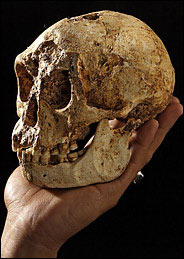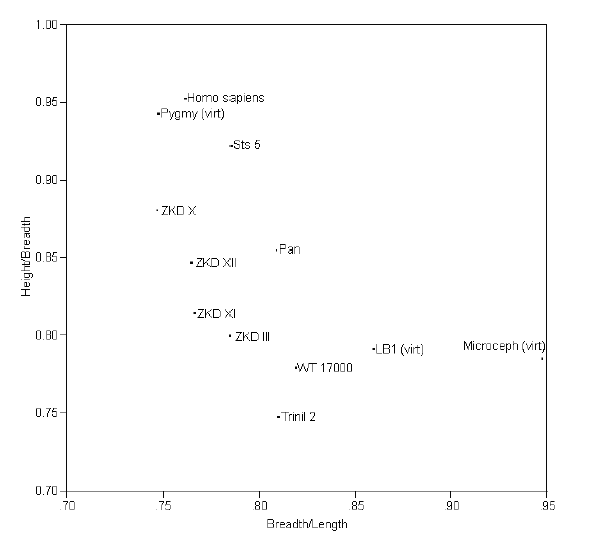March 03, 2005
Disagreements continue about "Hobbit" brains
 Science Express has just published a new study of (a virtual endocast from) the skull of (specimen LB1 of) Homo floresiensis. The abstract:
Science Express has just published a new study of (a virtual endocast from) the skull of (specimen LB1 of) Homo floresiensis. The abstract:
The brain of Homo floresiensis is assessed by comparing a virtual endocast from the type specimen (LB1) with endocasts from great apes, Homo erectus, Homo sapiens, a human pygmy, a human microcephalic, Sts 5 (Australopithecus africanus) and WT 17000 (Paranthropus aeithiopicus). Morphometric , allometric and shape data indicate that LB1 is not a microcephalic or pygmy. LB1's brain size versus body size scales like an australopithecine, but its endocast shape resembles that of Homo erectus. LB1 has derived frontal and temporal lobes and a lunate sulcus in a derived position, which are consistent with capabilities for higher cognitive processing.
However, an AP wire service story on the paper quotes "some other researchers" as "sticking to their opinion that the Hobbit probably suffered from a form of microcephaly, a condition in which the brain fails to grow at a normal rate, resulting in a small head with a large face, and even dwarfism."
What it is not, says primatologist Robert Martin, provost of the Field Museum in Chicago, is a scaled-down version of a Homo erectus or a new transitional species that held on for millennia in tropical isolation.
As I noted in an earlier post, "this is all a bit of a black eye for physical anthropology. If paleontologists (and Science magazine!) can't agree about such a basic question, something is wrong."
In particular, the amount of quantitative data on statistical norms for various modern populations seems to be surprisingly small. At least, not much of it is used in this Science paper, whose plots and tables generally represent each species or group as a single point (e.g. in the plot of endocast Height/Breadth against Breadth/Length reproduced below, where there are individual points for "Homo sapiens", "Pan", "Pygmy" and "Microceph", as well as for various individual fossil skulls).

[Update: There's a NYT article today (2/4/2005) by John Noble Wilford, with a somewhat clearer quote from Martin:
Dr. Robert Martin, a primatologist at the Field Museum in Chicago, said that he and colleagues in Britain were preparing a paper contending that the examined braincase was too small to be explained easily by ordinary dwarfism or the tendency of isolated people on islands to become smaller over generations. In such cases, Dr. Martin said, brain size would usually not diminish by the same amount as body size. Dr. Martin said that he was not ready to rule out microcephaly on the basis of a test of a single microcephalic braincase.
One other thing that bothers me a little about this discussion is that the original find was not actually a fossil -- in the sense of being mineralized -- but was preserved in some other way that left it with a consistency described as similar to "mashed potatoes" or "wet blotting paper" (see the quote from the original issue of Science in my post here). Given this, how secure can anyone's estimate of the skull's aspect ratio really be? ]
Posted by Mark Liberman at March 3, 2005 05:01 PM